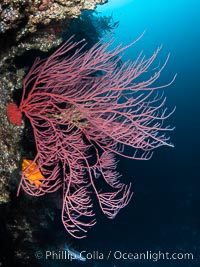
Red gorgonian on rocky reef, below kelp forest, underwater. The red gorgonian is a filter-feeding temperate colonial species that lives on the rocky bottom at depths between 50 to 200 feet deep. Gorgonians are typically oriented at right angles to prevailing water currents to capture plankton drifting by.
Species: Red gorgonian, Leptogorgia chilensis, Lophogorgia chilensis
Location: San Clemente Island, California
Image ID: 38519
Species: Red gorgonian, Leptogorgia chilensis, Lophogorgia chilensis
Location: San Clemente Island, California
Image ID: 38519
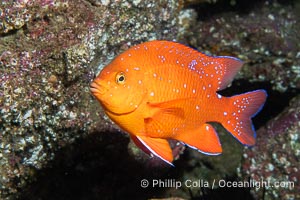
Juvenile garibaldi, vibrant spots distinguish it from pure orange adult form.
Species: Garibaldi, Hypsypops rubicundus
Location: Catalina Island, California
Image ID: 40528
Species: Garibaldi, Hypsypops rubicundus
Location: Catalina Island, California
Image ID: 40528
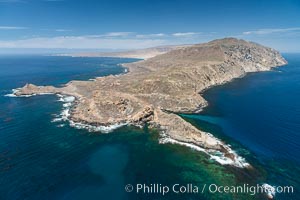
San Clemente Island Pyramid Head, the distinctive pyramid shaped southern end of the island.
Location: San Clemente Island, California
Image ID: 29357
Location: San Clemente Island, California
Image ID: 29357
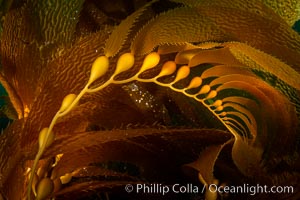
Kelp fronds and pneumatocysts. Pneumatocysts, gas-filled bladders, float the kelp plant off the ocean bottom toward the surface and sunlight, where the leaf-like blades and stipes of the kelp plant grow fastest. Giant kelp can grow up to 2' in a single day given optimal conditions. Epic submarine forests of kelp grow throughout California's Southern Channel Islands.
Species: Giant kelp, Macrocystis pyrifera
Location: San Clemente Island, California
Image ID: 34599
Species: Giant kelp, Macrocystis pyrifera
Location: San Clemente Island, California
Image ID: 34599
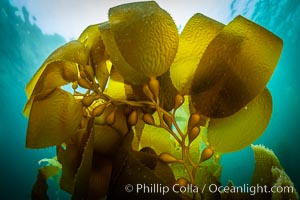
Kelp fronds and pneumatocysts. Pneumatocysts, gas-filled bladders, float the kelp plant off the ocean bottom toward the surface and sunlight, where the leaf-like blades and stipes of the kelp plant grow fastest. Giant kelp can grow up to 2' in a single day given optimal conditions. Epic submarine forests of kelp grow throughout California's Southern Channel Islands.
Species: Giant kelp, Macrocystis pyrifera
Location: San Clemente Island, California
Image ID: 34600
Species: Giant kelp, Macrocystis pyrifera
Location: San Clemente Island, California
Image ID: 34600
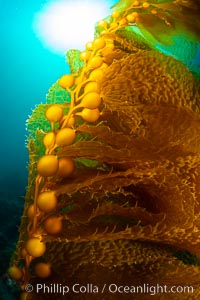
Kelp fronds and pneumatocysts. Pneumatocysts, gas-filled bladders, float the kelp plant off the ocean bottom toward the surface and sunlight, where the leaf-like blades and stipes of the kelp plant grow fastest. Giant kelp can grow up to 2' in a single day given optimal conditions. Epic submarine forests of kelp grow throughout California's Southern Channel Islands.
Species: Giant kelp, Macrocystis pyrifera
Location: San Clemente Island, California
Image ID: 34601
Species: Giant kelp, Macrocystis pyrifera
Location: San Clemente Island, California
Image ID: 34601
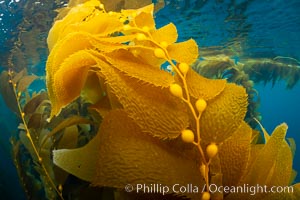
Kelp fronds and pneumatocysts. Pneumatocysts, gas-filled bladders, float the kelp plant off the ocean bottom toward the surface and sunlight, where the leaf-like blades and stipes of the kelp plant grow fastest. Giant kelp can grow up to 2' in a single day given optimal conditions. Epic submarine forests of kelp grow throughout California's Southern Channel Islands.
Species: Giant kelp, Macrocystis pyrifera
Location: San Clemente Island, California
Image ID: 34602
Species: Giant kelp, Macrocystis pyrifera
Location: San Clemente Island, California
Image ID: 34602
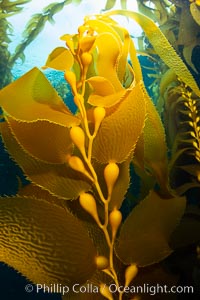
Kelp fronds and pneumatocysts. Pneumatocysts, gas-filled bladders, float the kelp plant off the ocean bottom toward the surface and sunlight, where the leaf-like blades and stipes of the kelp plant grow fastest. Giant kelp can grow up to 2' in a single day given optimal conditions. Epic submarine forests of kelp grow throughout California's Southern Channel Islands.
Species: Giant kelp, Macrocystis pyrifera
Location: San Clemente Island, California
Image ID: 34603
Species: Giant kelp, Macrocystis pyrifera
Location: San Clemente Island, California
Image ID: 34603
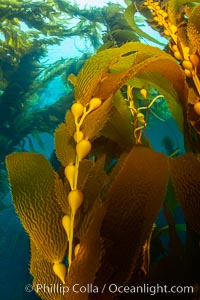
Kelp fronds and pneumatocysts. Pneumatocysts, gas-filled bladders, float the kelp plant off the ocean bottom toward the surface and sunlight, where the leaf-like blades and stipes of the kelp plant grow fastest. Giant kelp can grow up to 2' in a single day given optimal conditions. Epic submarine forests of kelp grow throughout California's Southern Channel Islands.
Species: Giant kelp, Macrocystis pyrifera
Location: San Clemente Island, California
Image ID: 34604
Species: Giant kelp, Macrocystis pyrifera
Location: San Clemente Island, California
Image ID: 34604
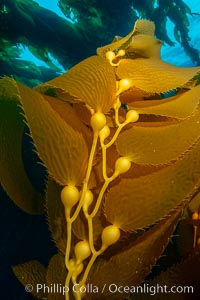
Kelp fronds and pneumatocysts. Pneumatocysts, gas-filled bladders, float the kelp plant off the ocean bottom toward the surface and sunlight, where the leaf-like blades and stipes of the kelp plant grow fastest. Giant kelp can grow up to 2' in a single day given optimal conditions. Epic submarine forests of kelp grow throughout California's Southern Channel Islands.
Species: Giant kelp, Macrocystis pyrifera
Location: San Clemente Island, California
Image ID: 34605
Species: Giant kelp, Macrocystis pyrifera
Location: San Clemente Island, California
Image ID: 34605
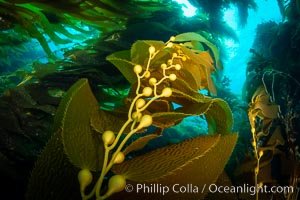
Kelp fronds and pneumatocysts. Pneumatocysts, gas-filled bladders, float the kelp plant off the ocean bottom toward the surface and sunlight, where the leaf-like blades and stipes of the kelp plant grow fastest. Giant kelp can grow up to 2' in a single day given optimal conditions. Epic submarine forests of kelp grow throughout California's Southern Channel Islands.
Species: Giant kelp, Macrocystis pyrifera
Location: San Clemente Island, California
Image ID: 34606
Species: Giant kelp, Macrocystis pyrifera
Location: San Clemente Island, California
Image ID: 34606
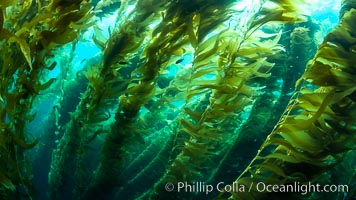
The Kelp Forest of San Clemente Island, California. A kelp forest. Giant kelp grows rapidly, up to 2' per day, from the rocky reef on the ocean bottom to which it is anchored, toward the ocean surface where it spreads to form a thick canopy. Myriad species of fishes, mammals and invertebrates form a rich community in the kelp forest. Lush forests of kelp are found throughout California's Southern Channel Islands.
Species: Giant kelp, Macrocystis pyrifera
Location: San Clemente Island, California
Image ID: 34609
Species: Giant kelp, Macrocystis pyrifera
Location: San Clemente Island, California
Image ID: 34609
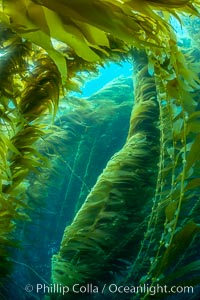
The Kelp Forest of San Clemente Island, California. A kelp forest. Giant kelp grows rapidly, up to 2' per day, from the rocky reef on the ocean bottom to which it is anchored, toward the ocean surface where it spreads to form a thick canopy. Myriad species of fishes, mammals and invertebrates form a rich community in the kelp forest. Lush forests of kelp are found throughout California's Southern Channel Islands.
Species: Giant kelp, Macrocystis pyrifera
Location: San Clemente Island, California
Image ID: 34610
Species: Giant kelp, Macrocystis pyrifera
Location: San Clemente Island, California
Image ID: 34610
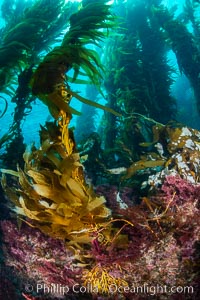
The Kelp Forest of San Clemente Island, California. A kelp forest. Giant kelp grows rapidly, up to 2' per day, from the rocky reef on the ocean bottom to which it is anchored, toward the ocean surface where it spreads to form a thick canopy. Myriad species of fishes, mammals and invertebrates form a rich community in the kelp forest. Lush forests of kelp are found throughout California's Southern Channel Islands.
Species: Giant kelp, Macrocystis pyrifera
Location: San Clemente Island, California
Image ID: 34611
Species: Giant kelp, Macrocystis pyrifera
Location: San Clemente Island, California
Image ID: 34611
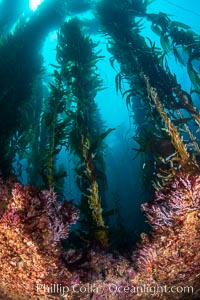
The Kelp Forest of San Clemente Island, California. A kelp forest. Giant kelp grows rapidly, up to 2' per day, from the rocky reef on the ocean bottom to which it is anchored, toward the ocean surface where it spreads to form a thick canopy. Myriad species of fishes, mammals and invertebrates form a rich community in the kelp forest. Lush forests of kelp are found throughout California's Southern Channel Islands.
Species: Giant kelp, Macrocystis pyrifera
Location: San Clemente Island, California
Image ID: 34612
Species: Giant kelp, Macrocystis pyrifera
Location: San Clemente Island, California
Image ID: 34612
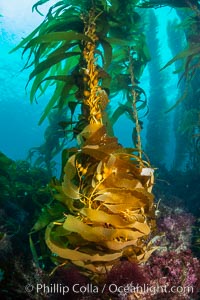
The Kelp Forest of San Clemente Island, California. A kelp forest. Giant kelp grows rapidly, up to 2' per day, from the rocky reef on the ocean bottom to which it is anchored, toward the ocean surface where it spreads to form a thick canopy. Myriad species of fishes, mammals and invertebrates form a rich community in the kelp forest. Lush forests of kelp are found throughout California's Southern Channel Islands.
Species: Giant kelp, Macrocystis pyrifera
Location: San Clemente Island, California
Image ID: 34613
Species: Giant kelp, Macrocystis pyrifera
Location: San Clemente Island, California
Image ID: 34613
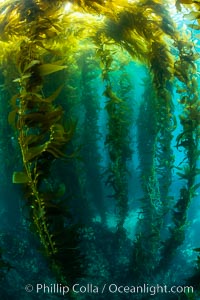
The Kelp Forest of San Clemente Island, California. A kelp forest. Giant kelp grows rapidly, up to 2' per day, from the rocky reef on the ocean bottom to which it is anchored, toward the ocean surface where it spreads to form a thick canopy. Myriad species of fishes, mammals and invertebrates form a rich community in the kelp forest. Lush forests of kelp are found throughout California's Southern Channel Islands.
Species: Giant kelp, Macrocystis pyrifera
Location: San Clemente Island, California
Image ID: 34614
Species: Giant kelp, Macrocystis pyrifera
Location: San Clemente Island, California
Image ID: 34614
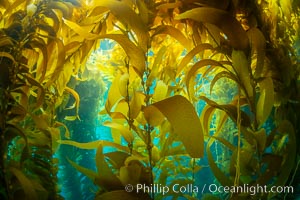
The Kelp Forest of San Clemente Island, California. A kelp forest. Giant kelp grows rapidly, up to 2' per day, from the rocky reef on the ocean bottom to which it is anchored, toward the ocean surface where it spreads to form a thick canopy. Myriad species of fishes, mammals and invertebrates form a rich community in the kelp forest. Lush forests of kelp are found throughout California's Southern Channel Islands.
Species: Giant kelp, Macrocystis pyrifera
Location: San Clemente Island, California
Image ID: 34615
Species: Giant kelp, Macrocystis pyrifera
Location: San Clemente Island, California
Image ID: 34615
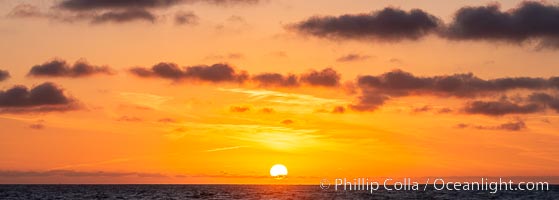
Sunset over the Pacific Ocean.
Location: San Clemente Island, California
Image ID: 38511
Panorama dimensions: 4540 x 12694
Location: San Clemente Island, California
Image ID: 38511
Panorama dimensions: 4540 x 12694
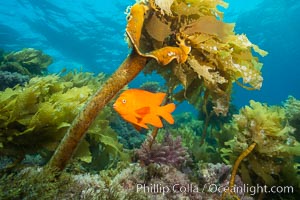
Garibaldi swimming through southern sea palm, San Clemente Island.
Species: Garibaldi, Southern sea palm, Eisenia arborea, Hypsypops rubicundus
Location: San Clemente Island, California
Image ID: 30877
Species: Garibaldi, Southern sea palm, Eisenia arborea, Hypsypops rubicundus
Location: San Clemente Island, California
Image ID: 30877
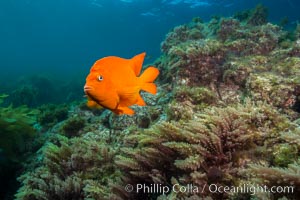
Garibaldi and Asparagopsis taxiformis (red marine algae), San Clemente Island.
Species: Garibaldi, Asparagopsis taxiformis, Hypsypops rubicundus
Location: San Clemente Island, California
Image ID: 30882
Species: Garibaldi, Asparagopsis taxiformis, Hypsypops rubicundus
Location: San Clemente Island, California
Image ID: 30882
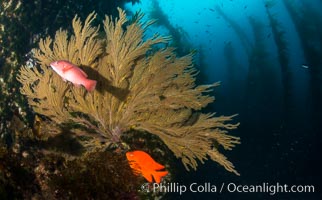
California golden gorgonian, Garibaldi and Sheephead wrasse fishes on rocky reef, below kelp forest, underwater. The golden gorgonian is a filter-feeding temperate colonial species that lives on the rocky bottom at depths between 50 to 200 feet deep. Each individual polyp is a distinct animal, together they secrete calcium that forms the structure of the colony. Gorgonians are oriented at right angles to prevailing water currents to capture plankton drifting by.
Species: California golden gorgonian, California sheephead wrasse, Garibaldi, Hypsypops rubicundus, Muricea californica, Semicossyphus pulcher
Location: San Clemente Island, California
Image ID: 30922
Species: California golden gorgonian, California sheephead wrasse, Garibaldi, Hypsypops rubicundus, Muricea californica, Semicossyphus pulcher
Location: San Clemente Island, California
Image ID: 30922
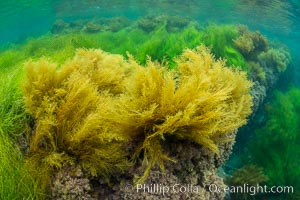
Stephanocystis dioica (yellow) and surfgrass (green), shallow water, San Clemente Island.
Species: Surfgrass, Phyllospadix, Stephanocystis dioica
Location: San Clemente Island, California
Image ID: 30946
Species: Surfgrass, Phyllospadix, Stephanocystis dioica
Location: San Clemente Island, California
Image ID: 30946
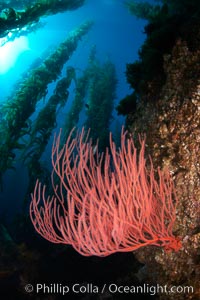
Red gorgonian on rocky reef, below kelp forest, underwater. The red gorgonian is a filter-feeding temperate colonial species that lives on the rocky bottom at depths between 50 to 200 feet deep. Gorgonians are oriented at right angles to prevailing water currents to capture plankton drifting by.
Species: Red gorgonian, Leptogorgia chilensis, Lophogorgia chilensis, Macrocystis pyrifera
Location: San Clemente Island, California
Image ID: 23420
Species: Red gorgonian, Leptogorgia chilensis, Lophogorgia chilensis, Macrocystis pyrifera
Location: San Clemente Island, California
Image ID: 23420
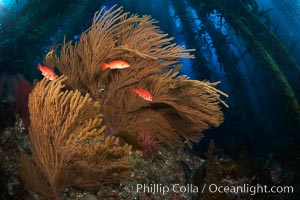
California golden gorgonian and small juvenile sheephead fishes on rocky reef, below kelp forest, underwater. The golden gorgonian is a filter-feeding temperate colonial species that lives on the rocky bottom at depths between 50 to 200 feet deep. Each individual polyp is a distinct animal, together they secrete calcium that forms the structure of the colony. Gorgonians are oriented at right angles to prevailing water currents to capture plankton drifting by.
Species: California golden gorgonian, Muricea californica, Semicossyphus pulcher
Location: San Clemente Island, California
Image ID: 23421
Species: California golden gorgonian, Muricea californica, Semicossyphus pulcher
Location: San Clemente Island, California
Image ID: 23421
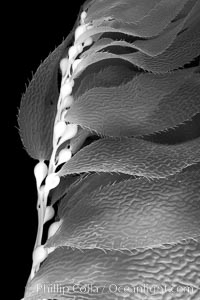
Kelp fronds and pneumatocysts. Pneumatocysts, gas-filled bladders, float the kelp plant off the ocean bottom toward the surface and sunlight, where the leaf-like blades and stipes of the kelp plant grow fastest. Giant kelp can grow up to 2' in a single day given optimal conditions. Epic submarine forests of kelp grow throughout California's Southern Channel Islands.
Species: Giant kelp, Macrocystis pyrifera
Location: San Clemente Island, California
Image ID: 23424
Species: Giant kelp, Macrocystis pyrifera
Location: San Clemente Island, California
Image ID: 23424
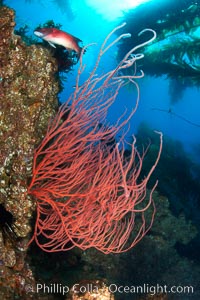
Red gorgonian on rocky reef, below kelp forest, underwater. The red gorgonian is a filter-feeding temperate colonial species that lives on the rocky bottom at depths between 50 to 200 feet deep. Gorgonians are oriented at right angles to prevailing water currents to capture plankton drifting by.
Species: Red gorgonian, Leptogorgia chilensis, Lophogorgia chilensis
Location: San Clemente Island, California
Image ID: 23425
Species: Red gorgonian, Leptogorgia chilensis, Lophogorgia chilensis
Location: San Clemente Island, California
Image ID: 23425
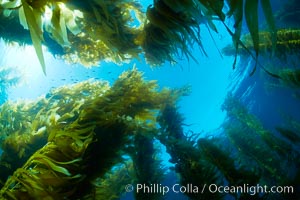
Giant kelp plants lean over in ocean currents, underwater. Individual kelp plants grow from the rocky reef, to which they are attached, up to the ocean surface and form a vibrant community in which fishes, mammals and invertebrates thrive.
Species: Giant kelp, Macrocystis pyrifera
Location: San Clemente Island, California
Image ID: 23426
Species: Giant kelp, Macrocystis pyrifera
Location: San Clemente Island, California
Image ID: 23426
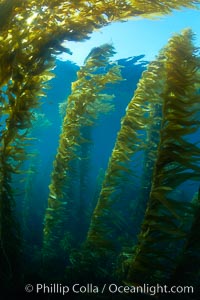
A kelp forest. Giant kelp grows rapidly, up to 2' per day, from the rocky reef on the ocean bottom to which it is anchored, toward the ocean surface where it spreads to form a thick canopy. Myriad species of fishes, mammals and invertebrates form a rich community in the kelp forest. Lush forests of kelp are found through California's Southern Channel Islands.
Species: Giant kelp, Macrocystis pyrifera
Location: San Clemente Island, California
Image ID: 23428
Species: Giant kelp, Macrocystis pyrifera
Location: San Clemente Island, California
Image ID: 23428
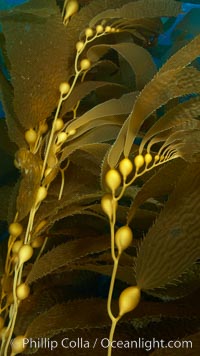
Kelp fronds and pneumatocysts. Pneumatocysts, gas-filled bladders, float the kelp plant off the ocean bottom toward the surface and sunlight, where the leaf-like blades and stipes of the kelp plant grow fastest. Giant kelp can grow up to 2' in a single day given optimal conditions. Epic submarine forests of kelp grow throughout California's Southern Channel Islands.
Species: Giant kelp, Macrocystis pyrifera
Location: San Clemente Island, California
Image ID: 23430
Species: Giant kelp, Macrocystis pyrifera
Location: San Clemente Island, California
Image ID: 23430